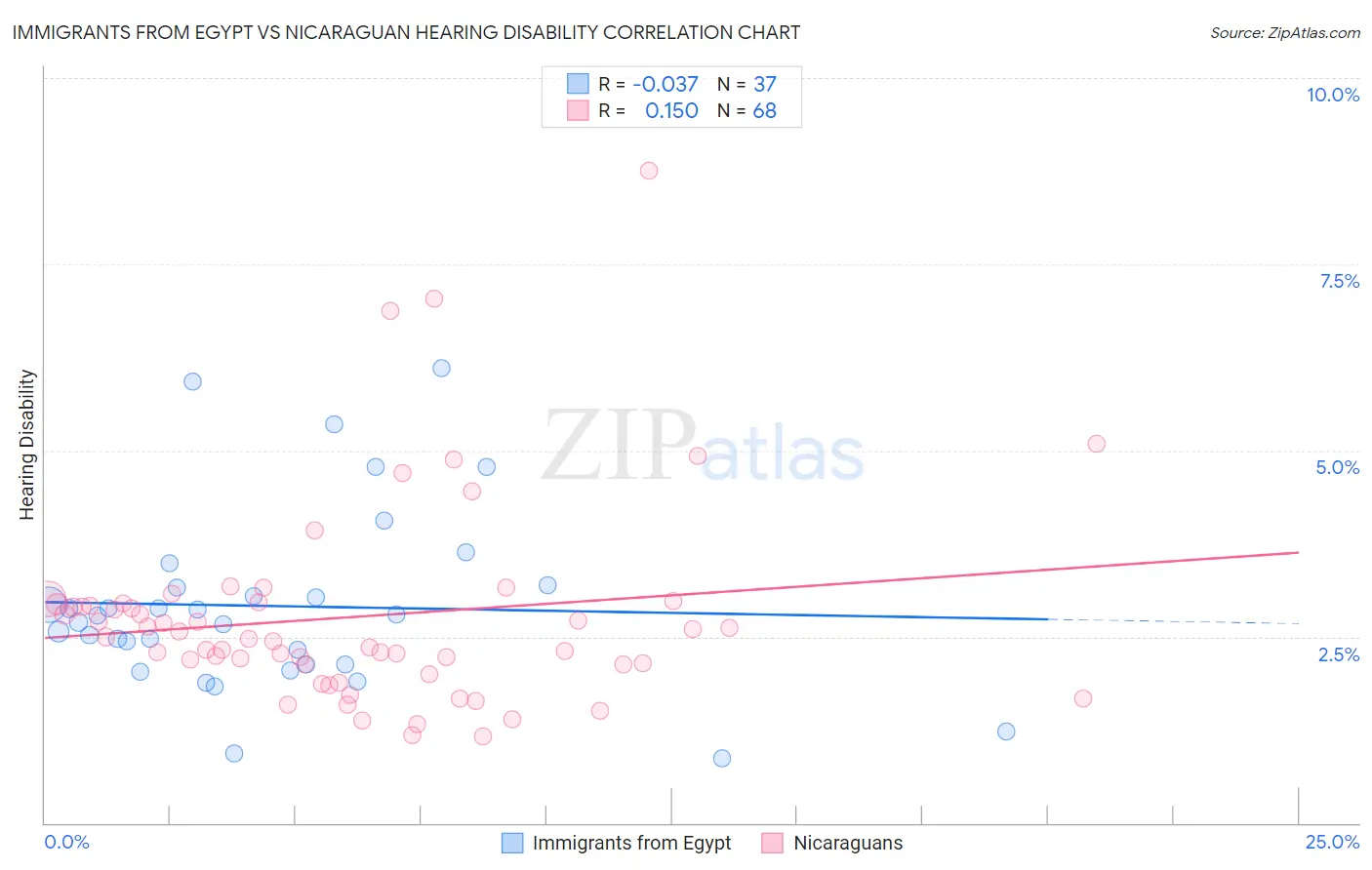Immigrants from Egypt vs Nicaraguan Hearing Disability
COMPARE
Immigrants from Egypt
Nicaraguan
Hearing Disability
Hearing Disability Comparison
Immigrants from Egypt
Nicaraguans
2.7%
HEARING DISABILITY
98.5/ 100
METRIC RATING
60th/ 347
METRIC RANK
2.7%
HEARING DISABILITY
97.9/ 100
METRIC RATING
69th/ 347
METRIC RANK
Immigrants from Egypt vs Nicaraguan Hearing Disability Correlation Chart
The statistical analysis conducted on geographies consisting of 245,432,770 people shows no correlation between the proportion of Immigrants from Egypt and percentage of population with hearing disability in the United States with a correlation coefficient (R) of -0.037 and weighted average of 2.7%. Similarly, the statistical analysis conducted on geographies consisting of 285,654,753 people shows a poor positive correlation between the proportion of Nicaraguans and percentage of population with hearing disability in the United States with a correlation coefficient (R) of 0.150 and weighted average of 2.7%, a difference of 0.85%.

Hearing Disability Correlation Summary
| Measurement | Immigrants from Egypt | Nicaraguan |
| Minimum | 0.86% | 1.2% |
| Maximum | 6.1% | 8.8% |
| Range | 5.3% | 7.6% |
| Mean | 2.9% | 2.8% |
| Median | 2.8% | 2.5% |
| Interquartile 25% (IQ1) | 2.1% | 2.1% |
| Interquartile 75% (IQ3) | 3.2% | 2.9% |
| Interquartile Range (IQR) | 1.1% | 0.81% |
| Standard Deviation (Sample) | 1.2% | 1.4% |
| Standard Deviation (Population) | 1.2% | 1.3% |
Demographics Similar to Immigrants from Egypt and Nicaraguans by Hearing Disability
In terms of hearing disability, the demographic groups most similar to Immigrants from Egypt are Immigrants from Eritrea (2.7%, a difference of 0.070%), Immigrants from Uzbekistan (2.7%, a difference of 0.13%), Immigrants from Colombia (2.7%, a difference of 0.14%), Immigrants from Peru (2.7%, a difference of 0.18%), and Indian (Asian) (2.7%, a difference of 0.19%). Similarly, the demographic groups most similar to Nicaraguans are Immigrants from Africa (2.7%, a difference of 0.040%), Egyptian (2.7%, a difference of 0.17%), Peruvian (2.7%, a difference of 0.23%), Central American (2.7%, a difference of 0.28%), and Afghan (2.7%, a difference of 0.38%).
| Demographics | Rating | Rank | Hearing Disability |
| Ethiopians | 99.0 /100 | #54 | Exceptional 2.7% |
| Immigrants | Ethiopia | 99.0 /100 | #55 | Exceptional 2.7% |
| Immigrants | Nicaragua | 99.0 /100 | #56 | Exceptional 2.7% |
| South Americans | 99.0 /100 | #57 | Exceptional 2.7% |
| Immigrants | Peru | 98.6 /100 | #58 | Exceptional 2.7% |
| Immigrants | Eritrea | 98.5 /100 | #59 | Exceptional 2.7% |
| Immigrants | Egypt | 98.5 /100 | #60 | Exceptional 2.7% |
| Immigrants | Uzbekistan | 98.4 /100 | #61 | Exceptional 2.7% |
| Immigrants | Colombia | 98.4 /100 | #62 | Exceptional 2.7% |
| Indians (Asian) | 98.4 /100 | #63 | Exceptional 2.7% |
| Immigrants | Sri Lanka | 98.4 /100 | #64 | Exceptional 2.7% |
| Immigrants | Nepal | 98.3 /100 | #65 | Exceptional 2.7% |
| Immigrants | Belize | 98.2 /100 | #66 | Exceptional 2.7% |
| Egyptians | 98.1 /100 | #67 | Exceptional 2.7% |
| Immigrants | Africa | 98.0 /100 | #68 | Exceptional 2.7% |
| Nicaraguans | 97.9 /100 | #69 | Exceptional 2.7% |
| Peruvians | 97.7 /100 | #70 | Exceptional 2.7% |
| Central Americans | 97.7 /100 | #71 | Exceptional 2.7% |
| Afghans | 97.6 /100 | #72 | Exceptional 2.7% |
| Argentineans | 97.5 /100 | #73 | Exceptional 2.7% |
| Immigrants | Korea | 97.5 /100 | #74 | Exceptional 2.7% |